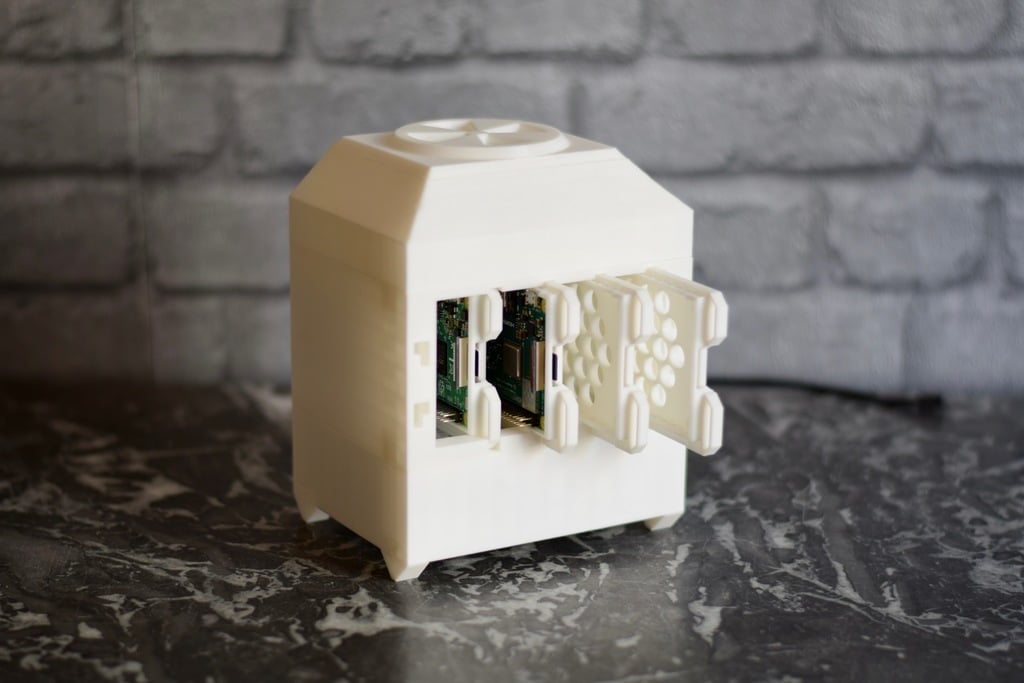
Raspberry Pi Bay - 4 slots
thingiverse
Good morning, folks! UPDATE 01/30/2021: Added, as requested in comments, three adapters for 40mm fans. I used a Noctua NF-A4x10 for the design. *Fan_Holder_40mm_Close*: Only one vent for the fan. *Fan_Holder_40mm_Open*: Opened chassis to benefit from airflow produced by the fan all around it. Might be quieter than close version, and airflow might be more homogeneous into space. *Fan_Holder_40mm_x4*: Adapter to use four fans of 40mm. I'm not sure if this is really better than a 90mm fan in terms of noise and even flow, but just in case. I'm super happy to present my latest design. I took advantage of this quarantine period to learn more about programming and set up several Raspberry Pi (RPi) as small home servers for various applications. However, after a while, I ended up with several raspberry pi hanging around my router. With the heat we've had recently, the Pi's were reaching over 55°C. Even though it's not a real problem, I thought that having a system to store them together and keep them cool would be a good thing for the upcoming summer. I have a hard drive bay attached to my NAS, and I thought such a system would be inspiring, which is why I came up with a Raspberry Pi bay where we can easily swap pi drives for different applications and tests. This bay is composed of several interchangeable parts. Most of them are easily customizable to fit other needs/designs. Here, the supplied set is made for a 92mm fan. I wanted to have the quietest solution, so I opted for a BeQuiet! 92mm PureWings 2. I quickly soldered two dupont male connectors to a micro-usb cable in order to connect the fan to a usb port. Of course, it's easy to rework the fan adapter a bit to fit smaller fans. Also, I've added several types of covers that offer different ventilation options. The one I printed is a dual system. The top vent can be opened or closed as needed. Select the grid version if you need more airflow, and the plain version if you need less. In all cases, the top cover also includes a grid to ensure that air can escape. The same modularity is available for the back plates. At the moment, two versions are available: a simple version if you don't have a Pi in this housing or if you don't need to connect a cable to it, and a version with a hole for the internet cable to connect it to an RPi 2 or 3. I will soon provide other versions with holes for the USB and ethernet ports of the RPi 4. Finally, for the dust filters, my printed version uses a honeycomb filter with a 10 to 20% infill depending on the part. Otherwise, you just need to print the "Case_Bot_NoPads" version of the part. For more info about the printing parameters I used, please have a look at the dedicated section below. An assembly video is available here: https://www.youtube.com/watch?v=gMeAFoPIWX0 After testing, my Raspberry Pi are now around 47°C (against 55°C previously), with a room ambient temperature of 27°C and two RPi loaded. So I can consider this bay as successfully working. List of material used (except 3D printed parts): 1. Raspberry Pi 3B 2. Raspberry Pi 3B+ 3. BeQuiet! 92mm PureWings 2 fan 4. Two micro-usb cables 5. One USB cable + two male dupont cables (soldered, for fan USB power) Additional info: In my case, I added some furniture pads in the bottom part where the fan adapter is in contact with the piece, to reduce vibration and noise. For this, you need to use the "Case_Bot_Pads" version of the part, with 15x4mm round or square pads. Otherwise, you just need to print the "Case_Bot_NoPads" version of the part. According to a benchmark from pidramble.com/wiki/benchmarks/power-consumption, the RPi 3B is much more energy efficient than the RPi 3B+ and RPi 4B. Therefore, if you want to save energy for economic or environmental reasons, I strongly advise you to opt for the 3B version. It's quite capable of running light applications such as chat servers (Rocket.Chat, mumble, etc.), VPN, etc. Furthermore, according to this benchmark from pidramble.com/wiki/benchmarks/power-consumption, the RPi 3B is much more energy efficient than the RPi 3B+ and RPi 4B. Therefore, if you want to save energy for economic or environmental reasons, I strongly advise you to opt for the 3B version. It's quite capable of running light applications such as chat servers (Rocket.Chat, mumble, etc.), VPN, etc. In addition, please note that the RPi 4B has a higher power consumption than the RPi 3B and RPi 3B+, which may lead to increased heat generation and reduced lifespan.
With this file you will be able to print Raspberry Pi Bay - 4 slots with your 3D printer. Click on the button and save the file on your computer to work, edit or customize your design. You can also find more 3D designs for printers on Raspberry Pi Bay - 4 slots.
